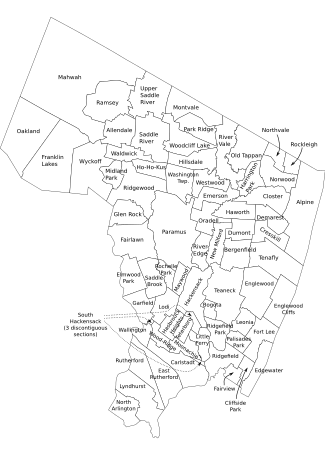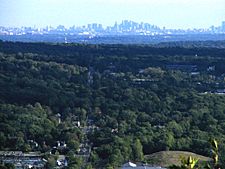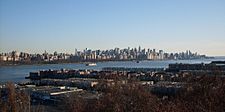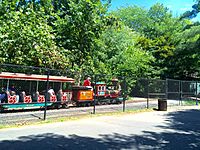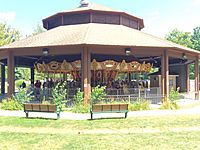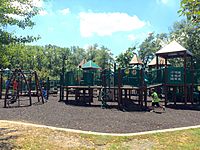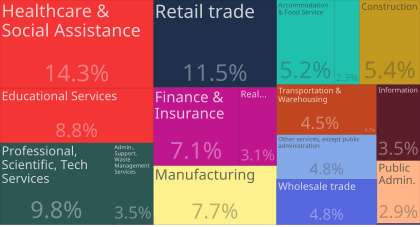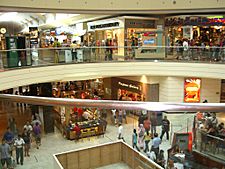Bergen County, New Jersey facts for kids
Quick facts for kids
Bergen County
|
|||
|---|---|---|---|
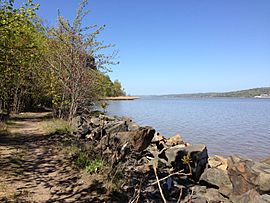
View north along the Shore Trail near the Forest View Trail in Palisades Interstate Park
|
|||
|
|||
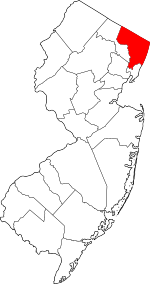
Location within the U.S. state of New Jersey
|
|||
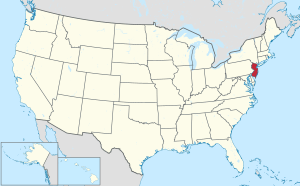 New Jersey's location within the U.S. |
|||
| Country | |||
| State | |||
| Founded | 1683 | ||
| Named for | Bergen, Norway or Bergen, North Holland | ||
| Seat | Hackensack | ||
| Largest municipality | Hackensack (population) Mahwah (area) |
||
| Area | |||
| • Total | 246.67 sq mi (638.87 km2) | ||
| • Land | 233.00 sq mi (603.49 km2) | ||
| • Water | 13.66 sq mi (35.38 km2) 5.54% | ||
| Population
(2020)
|
|||
| • Total | 955,732 | ||
| • Density | 4,101/sq mi (1,583/km2) | ||
| Demonym(s) | Bergenite | ||
| Time zone | UTC−5 (Eastern) | ||
| • Summer (DST) | UTC−4 (EDT) | ||
| Congressional districts | 5th, 8th, 9th | ||
Range in altitude: Highest elevation: 1,152 ft/351 m (Bald Mountain, in the Ramapo Mountains, in Mahwah). Lowest elevation: 0 ft/0 m (sea level), at the Hudson River in Edgewater. |
|||
Bergen County is the most populous county in the U.S. state of New Jersey. As of the 2020 United States Census, the county's population was 955,732, an increase of 50,616 (5.6%) from the 905,116 residents enumerated in the 2010 census by the United States Census Bureau, which in turn represented an increase of 20,998 (2.4%) from the 884,118 counted in the 2000 Census. Located in the northeastern corner of New Jersey and its Gateway Region, Bergen County is part of the New York City metropolitan area and is directly across the Hudson River from Manhattan, to which it is connected by the George Washington Bridge.
Bergen County is divided into 70 municipalities, but has no large cities. Its most populous place, with 43,010 residents at the time of the 2010 census, is Hackensack, which is also its county seat. Mahwah covered the largest area of any municipality, at 26.19 square miles (67.8 km2).
In 2015, the county had a per capita personal income of $75,849, the fourth-highest in New Jersey and ranked 45th of 3,113 counties in the United States. Bergen County is one of the wealthiest counties in the United States, with a median household income of $81,708 per the 2010 Census, increasing to an estimated $84,677 in 2014, which was almost 18% higher than the $71,919 median statewide. The county hosts an extensive park system with expansive greenways, totaling nearly 9,000 acres (3,600 ha).
Contents
Etymology
The origin of the name of Bergen County is a matter of debate. It is believed that the county is named for one of the earliest settlements, Bergen, in modern-day Hudson County. However, the origin of the township's name is debated. Several sources attribute the name to Bergen, Norway, while others attribute it to Bergen, North Holland in the Netherlands. Some sources say that the name is derived from one of the earliest settlers of New Amsterdam (now New York City), Hans Hansen Bergen, a native of Norway, who arrived in New Netherland in 1633.
History
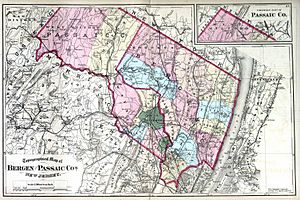
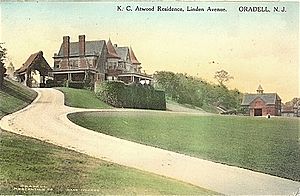
At the time of first European contact, Bergen County was inhabited by Native American people, particularly the Lenape Nation, whose sub-groups included the Tappan, Hackensack, and Rumachenanck (later called the Haverstraw), as named by the Dutch colonists. Some of their descendants are included among the Ramapough Mountain Indians, recognized as a tribe by the state in 1980. Their ancestors had moved into the mountains to escape encroachment by Dutch and English colonists. Their descendants reside mostly in the northwest of the county, in nearby Passaic County and in Rockland County, New York, tracing their Lenape ancestry to speakers of the Munsee language, one of three major dialects of their language. Over the years, they absorbed other ethnicities by intermarriage.
In the 17th century, the Dutch considered the area comprising today's Bergen and Hudson counties as part of New Netherland, their colonial province of the Dutch Republic. The Dutch claimed it after Henry Hudson (sailing for the Dutch East India Company) explored Newark Bay and anchored his ship at Weehawken Cove in 1609. From an early date, the Dutch began to import African slaves to fill their labor needs. Bergen County eventually was the largest slaveholding county in the state. The African slaves were used for labor at the ports to support shipping, as well as for domestic servants, trades, and farm labor.
Early settlement attempts by the Dutch included Pavonia (1633), Vriessendael (1640), and Achter Col (1642), but the Native Americans repelled these settlements in Kieft's War (1643–1645) and the Peach Tree War (1655–1660). European settlers returned to the western shores of the Hudson River in the 1660 formation of Bergen Township, which would become the first permanent European settlement in the territory of present-day New Jersey.
During the Second Anglo-Dutch War, on August 27, 1664, New Amsterdam's governor Peter Stuyvesant surrendered to the English Navy. The English organized the Province of New Jersey in 1665, later splitting the territory into East Jersey and West Jersey in 1674. On November 30, 1675, the settlement Bergen and surrounding plantations and settlements were called Bergen County in an act passed by the province's General Assembly. In 1683, Bergen (along with the three other original counties of East Jersey) was officially recognized as an independent county by the Provincial Assembly.
Initially, Bergen County consisted of only the land between the Hudson River and the Hackensack River, extending north to the border between East Jersey and New York. In January 1709, the boundaries were extended to include all of the current territory of Hudson County (formed in 1840) and portions of the current territory of Passaic County (formed in 1837). The 1709 borders were described as follows:
- "Beginning at Constable's Hook, so along the bay and Hudson's River to the partition point between New Jersey and the province of New York; along this line and the line between East and West Jersey† to the Pequaneck River; down the Pequaneck and Passaic Rivers to the sound; and so following the sound to Constable's Hook the place of beginning."
- † The line between East and West Jersey here referred to is not the line finally adopted and known as the Lawrence line, which was run by John Lawrence in September and October 1743. It was the compromise line agreed upon between Governors Daniel Coxe and Robert Barclay in 1682, which ran a little north of Morristown to the Passaic River; thence up the Pequaneck to forty-one degrees of north latitude; and thence by a straight line due east to the New York State line. This line being afterward objected to by the East Jersey proprietors, the latter procured the running of the Lawrence line.
Bergen was the location of several battles and troop movements during the American Revolutionary War. Fort Lee's location on the bluffs of the New Jersey Palisades, opposite Fort Washington in Manhattan, made it a strategic position during the war. In November 1776, the Battle of Fort Lee took place as part of a British plan to capture George Washington and to crush the Continental Army, whose forces were divided and located in Fort Lee and Hackensack. After abandoning the defenses in Fort Lee and leaving behind considerable supplies, the Continental forces staged a hasty retreat through present-day Englewood, Teaneck, and Bergenfield, and across the Hackensack River at New Bridge Landing, one of the few sites where the river was crossed by a bridge. They destroyed the bridge to delay the British assault on Washington's headquarters in village of Hackensack. The next day, George Washington retreated to Newark and left Hackensack via Polifly Road. British forces pursued, and Washington continued to retreat across New Jersey. The retreat allowed American forces to escape capture and regroup for subsequent successes against the British elsewhere in New Jersey later that winter. Soon after the Battle of Princeton in January 1777, British forces realized that they couldn't spread themselves thin across New Jersey. Local militia retook Hackensack and the rest of Bergen County. Bergen County saw skirmishes throughout the war as armies from both sides maneuvered across the countryside.
The Baylor Massacre took place in 1778 in River Vale, resulting in severe losses for the Continentals.
In 1837, Passaic County was formed from parts of Bergen and Essex counties. In 1840, Hudson County was formed from Bergen. These two divisions took roughly 13,000 residents (nearly half of the previous population) from the county's rolls.
In 1852, the Erie Railroad began operating major rail services from Jersey City on the Hudson River to points north and west via leased right-of-way in the county. This became known as the Erie Main Line, and is still in use for passenger service today. The Erie later leased two other railroads built in the 1850s and 1860s, later known as the Pascack Valley Line and the Northern Branch, and in 1881 built a cutoff, now the Bergen County Line. There were two other rail lines in the county, ultimately known as the West Shore Railroad and the New York, Susquehanna, and Western.
In 1894, state law was changed to allow easy formation of municipalities with the Borough form of government. This led to the "boroughitis" phenomenon, in which many new municipalities were created in a span of a few years. There were 26 boroughs that were formed in the county in 1894 alone, with two more boroughs (and one new township) formed in 1895.
On January 11, 1917, the Kingsland Explosion took place at a munitions factory in what is today Lyndhurst. The explosion is believed to have been an act of sabotage by German agents, as the munitions in question were destined for Russia, part of the U.S.'s effort to supply allies before entrance into World War I. After the U.S. entry into the war in April 1917, Camp Merritt was created in eastern Bergen County for troop staging. Beginning operations in August 1917, it housed 50,000 soldiers at a time, staging them for deployment to Europe via Hoboken. Camp Merritt was decommissioned in November 1919.
The George Washington Bridge was completed in 1931, linking Fort Lee to Manhattan. This connection spurred rapid development in the post-World War II era, developing much of the county to suburban levels. Two lanes were added to the upper level in 1946 and a second deck of traffic on the bridge was completed in 1962, expanding its capacity to 14 lanes.
In 1955, the United States Army created a Nike Missile station at Campgaw Mountain (in the west of the county) for the defense of the New York Metropolitan Area from strategic bombers. In 1959, the site was upgraded to house Nike-Hercules Missiles with increased range, speed, and payload characteristics. The missile site closed in June 1971.
Geography
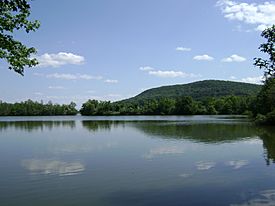
Bergen County is located at the northeastern corner of the state of New Jersey and is bordered by Rockland County, New York to the north; by Manhattan and the Bronx in New York City, as well as by Westchester County, New York, across the Hudson River to the east; and within New Jersey, by Hudson County as well as a small border with Essex County to the south, and by Passaic County to the west.
According to the United States Census Bureau, the county had a total area of 246.671 square miles (638.87 km2), of which 233.009 square miles (603.49 km2) (94.5%) was land and 13.662 square miles (35.38 km2) (5.5%) was water.
Bergen County's highest elevation is Bald Mountain near the New York state line in Mahwah, at 1,164 feet (355 m) above sea level. The county's lowest point is sea level, along the Hudson River, which in this region is a tidal estuary.
The sharp cliffs of the New Jersey Palisades lift much of the eastern boundary of the county up from the Hudson River. The relief becomes less pronounced across the middle section of the county, much of it being located in the Hackensack River valley or the Pascack Valley. In the northwestern portion of the county, Bergen County becomes hilly again and shares the Ramapo Mountains with Rockland County, New York.
The damming of the Hackensack River and a tributary, the Pascack Brook, produced three reservoirs in the county, Woodcliff Lake Reservoir (which impounds one billion gallons of water), Lake Tappan (3.5 billion gallons), and Oradell Reservoir, which allows United Water to provide drinking water to 750,000 residents of northern New Jersey, mostly in Bergen and Hudson counties. The Hackensack River drains the eastern portion of the county through the New Jersey Meadowlands, a wetlands area in the southern portion of the county. The central portion is drained by the Saddle River and the western portion is drained by the Ramapo River. Both of these are tributaries of the Passaic River, which forms a section of the southwestern border of the county.
 |
Rockland County, New York |  |
||
| Passaic County, New Jersey | Westchester, The Bronx, and Manhattan in New York City, across the Hudson River | |||
| Essex County and Hudson County, New Jersey |
Climate
| Weather chart for Hackensack, New Jersey | |||||||||||||||||||||||||||||||||||||||||||||||
|---|---|---|---|---|---|---|---|---|---|---|---|---|---|---|---|---|---|---|---|---|---|---|---|---|---|---|---|---|---|---|---|---|---|---|---|---|---|---|---|---|---|---|---|---|---|---|---|
| J | F | M | A | M | J | J | A | S | O | N | D | ||||||||||||||||||||||||||||||||||||
|
3.7
38
19
|
3.2
41
22
|
4.4
50
30
|
4.5
62
40
|
4.2
72
50
|
4.4
81
60
|
4.6
86
65
|
4.4
84
63
|
4.3
76
55
|
4.4
64
42
|
4
54
34
|
4
43
25
|
||||||||||||||||||||||||||||||||||||
| temperatures in °F precipitation totals in inches source: The Weather Channel |
|||||||||||||||||||||||||||||||||||||||||||||||
|
Metric conversion
|
|||||||||||||||||||||||||||||||||||||||||||||||
Southeastern Bergen County lies at the edge of the humid subtropical climate zone according to the Köppen climate classification because its coldest month (January) averages above 26.6 °F / -3 °C. In part due to Bergen's coastal location, its lower elevation, and the partial shielding of the county from colder air by the three ridges of the Watchung Mountains as well as by the higher Appalachians, the climate of Bergen County is milder than in New Jersey counties further inland such as Sussex County. Bergen County has a moderately sunny climate, averaging between 2,400 and 2,800 hours of sunshine annually.
In recent years, average temperatures in the county seat of Hackensack have ranged from a low of 19 °F (−7 °C) in January to a high of 86 °F (30 °C) in July, although a record low of −15 °F (−26 °C) was recorded in February 1934 and a record high of 106 °F (41 °C) was recorded in July 1936. Average monthly precipitation ranged from 3.21 inches (82 mm) in February to 4.60 inches (117 mm) in July.
Demographics
| Historical population | |||
|---|---|---|---|
| Census | Pop. | %± | |
| 1790 | 12,601 | — | |
| 1800 | 15,156 | 20.3% | |
| 1810 | 16,603 | 9.5% | |
| 1820 | 18,178 | 9.5% | |
| 1830 | 22,412 | 23.3% | |
| 1840 | 13,223 | −41.0% | |
| 1850 | 14,725 | 11.4% | |
| 1860 | 21,618 | 46.8% | |
| 1870 | 30,122 | 39.3% | |
| 1880 | 36,786 | 22.1% | |
| 1890 | 47,226 | 28.4% | |
| 1900 | 78,441 | 66.1% | |
| 1910 | 138,002 | 75.9% | |
| 1920 | 210,703 | 52.7% | |
| 1930 | 364,977 | 73.2% | |
| 1940 | 409,646 | 12.2% | |
| 1950 | 539,139 | 31.6% | |
| 1960 | 780,255 | 44.7% | |
| 1970 | 897,148 | 15.0% | |
| 1980 | 845,385 | −5.8% | |
| 1990 | 825,380 | −2.4% | |
| 2000 | 884,118 | 7.1% | |
| 2010 | 905,116 | 2.4% | |
| 2020 | 955,732 | 5.6% | |
| Historical sources: 1790–1990 1970–2010 2020 |
|||
2020 Census
As of the Census of 2020, the county had 955,732 people, 343,733 households, and 242,272 families. The population density was 3,900 inhabitants per square mile (1,505.8/km2). There were 367,383 housing units at an average density of 1,576 per square mile (608.5/km2). The county racial makeup was 56.90% White, 5.73% African American, 0.47% Native American, 16.59% Asian, and 10.17% from two or more races. Hispanic or Latino of any race were 21.41% of the population.
There were 343,733 households, of which 29.7% had children under the age of 18 living with them, 57.1% were married couples living together, 24.7% had a female householder with no husband present, 13.9% had a male householder with no wife present and 29.5% were non-families. 14.1% of all households were made up of individuals, and 11.3% had someone living alone who was 65 years of age or older. The average household size was 3.18 and the average family size was 3.25.
About 21.3% of the county's population was under age 18, 8.0% was from age 18 to 24, 36.7% was from age 15 to 44, and 17.0% was age 65 or older. The median age was 42.1 years. The gender makeup was 48.53% male and 51.14% female. For every 100 females, there were 94.3 males.
The median household income was $108,827, and the median family income was $122,981. About 5.6% of the population were below the poverty line, including 7.4% of those under age 18 and 7.7% of those age 65 or over.
2010 Census
As of the census of 2010, there were 905,116 people, 335,730 households, and 238,704 families residing in the county. The population density was 3,884.5 per square mile (1,499.8/km2). There were 352,388 housing units at an average density of 1,512.3 per square mile (583.9/km2)*. The racial makeup of the county was 71.89% (650,703) White, 5.80% (52,473) Black or African American, 0.23% (2,061) Native American, 14.51% (131,329) Asian, 0.03% (229) Pacific Islander, 5.04% (45,611) from other races, and 2.51% (22,710) from two or more races. [[Hispanic (U.S. Census)|Hispanic or Latino of any race were 16.05% (145,281) of the population.
There were 335,730 households out of which 32% had children under the age of 18 living with them, 56.1% were married couples living together, 10.9% had a female householder with no husband present, and 28.9% were non-families. 24.6% of all households were made up of individuals, and 10.5% had someone living alone who was 65 years of age or older. The average household size was 2.66 and the average family size was 3.2.
In the county, the population was spread out with 22.6% under the age of 18, 7.4% from 18 to 24, 25.9% from 25 to 44, 29% from 45 to 64, and 15.1% who were 65 years of age or older. The median age was 41.1 years. For every 100 females there were 92.9 males. For every 100 females ages 18 and old there were 89.8 males.
Community diversity
Given its location as a suburban extension of Manhattan across the George Washington Bridge, Bergen County has evolved a globally cosmopolitan ambience of its own, demonstrating a robust and growing demographic and cultural diversity with respect to metrics including nationality, religion, race, and domiciliary partnership. South Korea, Poland, and India are the three most common nations of birth for foreign-born Bergen County residents.
Italian American
Italian Americans have long had a significant presence in Bergen County; in fact, Italian is the most commonly identified first ancestry among Bergen residents (18.5%), with 168,974 Bergen residents were recorded as being of Italian heritage in the 2013 American Community Survey.
To this day, many residents of the Meadowlands communities in the county's south are of Italian descent, most notably in South Hackensack (36.3%), Lyndhurst (33.8%), Carlstadt (31.2%), Wood-Ridge (30.9%) and Hasbrouck Heights (30.8%). Saddle Brook (29.8%), Lodi (29.4%), Moonachie (28.5%), Garfield, Hackensack, and the southeastern Bergen towns were Italian American strongholds for decades, but their Italo-American demographics have diminished in recent years as more recent immigrants have taken their place. At the same time, the Italian American population has grown in many of the communities in the northern half of the county, including Franklin Lakes, Ramsey, Montvale, and Woodcliff Lake.
Latin American
The diverse Hispanic and Latin American population in Bergen is growing in many areas of the county but is especially concentrated in a handful of municipalities, including Fairview (37.1%), Hackensack (25.9%), Ridgefield Park (22.2%), Englewood (21.8%), Bogota (21.3%), Garfield (20.1%), Cliffside Park (18.2%), Lodi (18.0%), and Bergenfield (17.0%). Traditionally, many of the Latino residents were of Colombian and Cuban ancestry, although that has been changing in recent years. Englewood's Colombian community is the largest in Bergen County and among the top ten in the United States (7.17%); Hackensack, Fairview, Bergenfield, Bogota, and Lodi also have notable populations. The Cuban population is largest in Fairview, Ridgefield Park, Ridgefield, and Bogota, although the Cuban community is much bigger in Hudson County to the south. Since 2000, an increasing number of immigrants from other countries have entered the region, including people from Peru, Mexico, Guatemala, El Salvador, the Dominican Republic, Ecuador, Chile, as well as from the U.S. territory of Puerto Rico. The diverse backgrounds of the local Latino community are best exemplified in Fairview, where 10% of the overall population hails from Central America, 7% from South America, and 9% from other Latin American countries, mainly the Caribbean. Overall, Bergen County's Latino population has demonstrated a robust increase from 145,281 in the 2010 census count to an estimated 165,442 in 2013.
Western European American
Irish Americans and German Americans are the next largest individual ethnic groups in Bergen County, numbering 115,914 in 2013 (12.7% of the county's total population) and 80,288 (8.8%) respectively. As is the case with Italian Americans, these two groups developed sizable enclaves long ago and are now well established in all areas of the county.
Jewish American
Bergen County is home to the largest Jewish population in New Jersey. Many municipalities in the county are home to a significant number of Jewish Americans, including Fair Lawn, Teaneck, Tenafly, Closter, Englewood, Englewood Cliffs, Fort Lee, Bergenfield, Woodcliff Lake, Paramus, and Franklin Lakes. Teaneck, Fair Lawn, Englewood, and Bergenfield in particular have become havens for Bergen County's growing Orthodox Jewish communities, with a rising number of synagogues as well as supermarkets and restaurants offering kosher foods. The largest Israeli American communities in Bergen County were in Fair Lawn (2.5%), Closter (1.4%), and Tenafly (1.3%) in 2000, representing three of the four largest in the state. Altogether, 83,700 Bergen residents identified themselves as being of Jewish heritage in 2000, a number expected to show an increase per a 2014 survey of Jews in the county.
Korean American
|
Koreatown, Palisades Park, Bergen County
팰리세이즈 파크 코리아타운
Palisades Park Koreatown
|
|
|---|---|
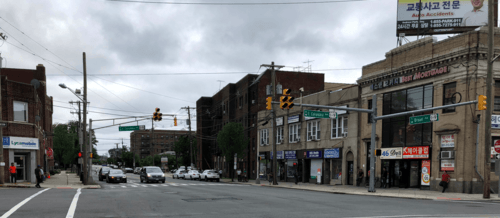
Broad Avenue in Koreatown, Palisades Park, a borough with ubiquitous Hangul signage, where Koreans comprise the majority (52%) of the population. South Koreans constituted the most prevalent foreign-born nationality in Bergen County, which was home to all of the nation's top ten municipalities by percentage of Korean population in 2010.
|
The top ten municipalities in the United States as ranked by Korean American percentage of overall population in 2010 are illustrated in the following table:
| Rank | Municipality | County | State | Percentage |
|---|---|---|---|---|
| 1 | Palisades Park | Bergen County | New Jersey | 51.5% |
| 2 | Leonia | Bergen County | New Jersey | 26.5% |
| 3 | Ridgefield | Bergen County | New Jersey | 25.7% |
| 4 | Fort Lee | Bergen County | New Jersey | 23.5% |
| 5 | Closter | Bergen County | New Jersey | 21.2% |
| 6 | Englewood Cliffs | Bergen County | New Jersey | 20.3% |
| 7 | Norwood | Bergen County | New Jersey | 20.1% |
| 8 | Edgewater | Bergen County | New Jersey | 19.6% |
| 9 | Cresskill | Bergen County | New Jersey | 17.8% |
| 10 | Demarest | Bergen County | New Jersey | 17.3% |
One of the fastest-growing immigrant groups in Bergen County is the Korean American community, which is concentrated along the Hudson River – especially in the area near the George Washington Bridge – and represented more than half of the state's entire Korean population as of 2000. As of the 2010 Census, persons of Korean ancestry made up 6.3% of Bergen County's population (increasing to 6.9% by the 2011 American Community Survey to an estimated 63,247 individuals), which is the highest percentage for any county in the United States; while the concentration of Koreans in Palisades Park, within Bergen County, is the highest density and percentage of any municipality in the United States, at 51.5% of the population. Per the 2010 Census, Palisades Park was home to the highest total number (10,115) of individuals of Korean ancestry among all municipalities in the state, while neighboring Fort Lee had the second largest cluster (8,318), and fourth highest proportion (23.5%, trailing Leonia (26.5%) and Ridgefield (25.7%)). All of the nation's top ten municipalities by percentage of Korean population in 2010 were located in Bergen County, including Palisades Park, Leonia, Ridgefield, Fort Lee, Closter, Englewood Cliffs, Norwood, Edgewater, Cresskill, and Demarest, closely followed by Old Tappan. Virtually all of the municipalities with the highest Korean concentrations are located in the eastern third of the county, near the Hudson River, although Ridgewood has emerged as a Korean American nexus in western Bergen County, and Paramus and River Edge in central Bergen County. Beginning in 2012, county election ballots were printed in the Korean language, in addition to English and Spanish, given the U.S Census Bureau's directive that Bergen County's Korean population had grown large enough to warrant language assistance during elections. Between 2011 and 2017, the Korean population of Fair Lawn was estimated to have more than doubled.
South Korean chaebols have established North American headquarters operations in Bergen County, including Samsung, LG Corp, and Hanjin Shipping. In April 2018, the largest Korean-themed supermarket in Bergen County opened in Paramus. In January 2019, Christopher Chung was sworn in as the first Korean-American mayor of Palisades Park.
The political stature of Koreatown appears to be increasing significantly as well. Bergen County's growing Korean community was cited by county executive Kathleen Donovan in the context of attorney Jae Y. Kim's appointment to Central Municipal Court judgeship in nearby Hackensack in January 2011. Subsequently, in March 2012, leaders from Bergen County's Korean community announced they would form a grassroots political action committee to gain an organized voice in politics in the wake of the rejection of attorney Phillip Kwon to the New Jersey Supreme Court by a state legislative body, and in July 2012, Kwon was appointed instead as deputy general counsel of the Port Authority of New York and New Jersey. Jacqueline Choi was then sworn in as Bergen County's first female Korean American assistant prosecutor in September 2012. According to The Record, the U.S. Census Bureau has determined that the county's Korean American population has grown enough to warrant language assistance during elections, and Bergen County's Koreans have earned significant political respect. As of May 2014, Korean Americans had garnered at least four borough council seats in Bergen County. In November 2016, Ellen Park was elected to the borough council in nearby Englewood Cliffs, while namesake Daniel Park was elected to the borough council in nearby Tenafly in November 2013.
Polish American
Polish Americans are well represented in western Bergen County and are growing as a community, with 59,294 (6.5%) of residents of Polish descent residing in the county as of the 2013 American Community Survey. The community's cultural and commercial heart has long been centered in Wallington, where 45.5% of the population is of Polish descent; this is the largest concentration among New Jersey municipalities and the seventh-highest in the United States. The adjacent city of Garfield has also become a magnet for Polish immigrants, with 22.9% of the population identifying themselves as being of Polish ancestry, the third highest concentration in the state.
African American
The county's African American community is almost entirely concentrated in three municipalities: Englewood (10,215 residents, accounting for 38.98% of the city's total population), Teaneck (11,298; 28.78%), and Hackensack (10,518; 24.65%). Collectively, these three areas account for nearly 70% of the county's total African American population of 46,568, and in fact, blacks have had a presence in these towns since the earliest days of the county. In sharp contrast, African Americans comprise less than 2% of the total in most of Bergen's other municipalities. In Englewood, the African American population is concentrated in the Third and Fourth wards of the western half of the city, while the northeastern section of Teaneck has been an African American enclave for several decades. In 2014, Teaneck selected its first female African-American mayor. Hackensack's long-established African American community is primarily located in the central part of the city, especially in the area near Central Avenue and First Street. Bergen County's black population has declined from 52,473 counted in the 2010 Census to an estimated 50,478 in 2012. Other county municipalities with a sizeable minority of African-Americans include Bergenfield (7.7%), Bogota (9.4%), Garfield (6.5%), Lodi (7.5%) and Ridgefield Park (6.4%)
Indian American
Indian Americans, or Asian Indians, represent a rapidly growing demographic in Bergen County, enumerating over 40,000 individuals in 2013, a significant increase from the 24,973 counted in the 2010 Census, and represent the second largest Asian ethnic group in Bergen County, after Korean Americans. The biggest clusters of Indian Americans are located in Hackensack, Ridgewood, Fair Lawn, Paramus, Teaneck, Mahwah, Bergenfield, Lodi, and Elmwood Park. Within the county's Indian population is America's largest Malayali community, and Kerala-based Kitex Garments, India's largest children's clothing manufacturer, opened its first U.S. office in Montvale in October 2015. Glen Rock resident Gurbir Grewal, a member of Bergen County's growing Indian American Sikh community, was sworn into the position of county prosecutor in 2016, and an architecturally notable Sikh gurudwara resides in Glen Rock, while a similarly prominent Hindu mandir has been built in Mahwah. The public library in Fair Lawn began a highly attended Hindi language (हिन्दी) storytelling program in October 2013. The affluent municipalities of northern Bergen County are witnessing significant growth in their Indian American communities, including Glen Rock, into which up to 90% of this constituency was estimated by one member in 2014 to have moved within the preceding two-year period alone. In February 2015, the board of education of the Glen Rock Public Schools voted to designate the Hindu holy day Diwali as an annual school holiday, making it the first district in the county to close for the holiday, while thousands celebrated the first county-wide celebration of Diwali under a unified sponsorship banner in 2016. An annual "Holi in the Village" festival of colors has been launched in Ridgewood.
Russian (and other former Soviet) American
Fair Lawn, Tenafly, Alpine, and Fort Lee are hubs for Russian Americans, including a growing community of Russian Jews. Garfield is home to an architecturally prominent Russian Orthodox church. Likewise, Ukrainian Americans, Georgian Americans, and Uzbek Americans have more recently followed the path of their Russian American predecessors to Bergen County, particularly to Fair Lawn. The size of Fair Lawn's Russian American presence has prompted an April Fool's satire titled, "Putin Moves Against Fair Lawn". The Armenian American population in Bergen is dispersed throughout the county, but its most significant concentration is in the southeastern towns near the George Washington Bridge. The victims of the Armenian genocide are recognized annually at the Bergen County Courthouse in Hackensack.
Filipino American
Bergenfield, along with Paramus, Hackensack, New Milford, Dumont, Fair Lawn, and Teaneck, have become growing hubs for Filipino Americans. Taken as a whole, these municipalities are home to a significant proportion of Bergen County's Philippine population. A census-estimated 20,859 Filipino Americans resided in Bergen County as of 2013, embodying an increase from the 19,155 counted in 2010. Between 2000 and 2010, the Filipino-American population of Bergenfield grew from 11.7%, or 3,081 residents, to 17.1%, or 4,569, and increasing further to 5,062 (18.4%) by 2016. Bergenfield is informally known as the Little Manila of Bergen County, with a significant concentration of Filipino residents and businesses. In the late 1990s, Bergenfield became the first municipality on the East Coast of the United States to elect a Filipino mayor, Robert C. Rivas. The annual Filipino American Festival is held in Bergenfield. The Philippine-American Community of Bergen County (PACBC) organization is based in Paramus, while other Filipino organizations are based in Fair Lawn and Bergenfield. Bergen County's culturally active Filipino community repatriated significant financial assistance to victims of Typhoon Haiyan, which ravaged the Philippines in November 2013. Between 2011 and 2017, Fair Lawn's Filipino population was estimated to have more than doubled. In 2021, the mulitnational conglomerate Jollibee restaurant chain based in Metro Manila, planned to open its first Bergen County location in East Rutherford.
Chinese American
The Chinese American population is also spread out, with sizable populations in Fort Lee, Paramus, Ridgewood, River Edge, and Englewood Cliffs. Fort Lee and Paramus have the highest total number of Chinese among Bergen municipalities while Englewood Cliffs has the highest percentage (8.42%). Several school districts throughout the county have added Mandarin to their curricula.
Japanese American
The Japanese community, which includes a significant number of Japanese nationals, has long had a presence in Fort Lee, with over a quarter of the county's total Japanese population living in that borough alone. Adjacent Edgewater has also developed an active Japanese American community, particularly after the construction of the largest Japanese-oriented commercial center on the U.S. East Coast in this borough. As of March 2011, about 2,500 Japanese Americans lived in Fort Lee and Edgewater combined; this is the largest concentration of Japanese Americans in New Jersey. The remainder of Bergen County's Japanese residents are concentrated in northern communities, including Ridgewood. The Japanese-American Society of New Jersey is based in Fort Lee.
Balkan American
Greek Americans have had a fairly sizable presence in Bergen for several decades, and according to 2000 census data, the Greek community numbered 13,247 county-wide. Greek restaurants are abundant in Bergen County. The largest concentrations of Greeks by percentage in the county are in Englewood Cliffs (7.2%), Alpine (5.2%), Fort Lee (3.7%), and Palisades Park (3.5%). Macedonian Americans and Albanian Americans have arrived relatively recently in New Jersey but have quickly established Bergen County enclaves, roughly in tandem, in Garfield, Elmwood Park, and Fair Lawn.
Iranian American
A relatively recent community of Iranian Americans has emerged in Bergen County, including those in professional occupations scattered throughout the county.
Muslims
Bergen County also has a moderate-sized Muslim population, which numbered 6,473 as of the 2000 census. Teaneck and Hackensack have emerged as the two most significant Muslim enclaves in the county, with the American Muslim Union's 18th annual brunch gathering held in Teaneck in 2016. Bergen's Muslim population primarily consists of Arab Americans, South Asian Americans, African Americans, and more recently, Macedonian Americans and Albanian Americans, although many members of these groups practice other religions. While Arab Americans have not established a significant presence in any particular municipality, in total there are 11,755 county residents who indicated Arab ancestry in the 2000 census. The overwhelming majority of Bergen's Arab American population (64.3%) is constituted by persons of Lebanese (2,576), Syrian (2,568), and Egyptian (2,417) descent. The county's diners provide late-night and pre-dawn dining options during the Islamic holy month of Ramadan.
Transportation
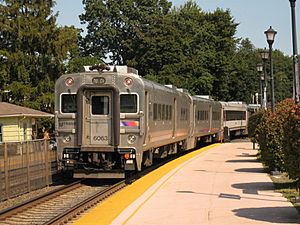
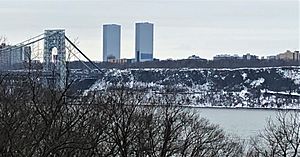
Bergen County has a highly developed road network, including the northern termini of the New Jersey Turnpike (a portion of Interstate 95) and the Garden State Parkway, the eastern terminus of Interstate 80, and a portion of Interstate 287. US Highways 1/9, 9W, 46, 202, and New Jersey state highways 3, 4, 17, 120, 208, and the Palisades Interstate Parkway also serve the region. With an average volume of 210,000 vehicles passing through each day, the intersection of Routes 4 and 17 is one of the busiest in the world.
The George Washington Bridge, connecting Fort Lee in Bergen County across the Hudson River to the Upper Manhattan section of New York City, is the world's busiest motor vehicle bridge. Access to New York City is alternatively available for motorists through the Lincoln Tunnel and Holland Tunnel in Hudson County. Access across the Hudson River to Westchester County in New York is available using the Tappan Zee Bridge in neighboring Rockland County, New York.
As of May 2010[update], the county had a total of 2,988.59 miles (4,809.67 km) of roadways, of which 2,402.78 miles (3,866.90 km) are maintained by the municipality, 438.97 miles (706.45 km) by Bergen County, 106.69 miles (171.70 km) by the New Jersey Department of Transportation, 11.03 miles (17.75 km) by the Palisades Interstate Parkway Commission, 27.94 miles (44.97 km) by the New Jersey Turnpike Authority and 1.18 miles (1.90 km) by the Port Authority of New York and New Jersey.
Train service is available on three lines from NJ Transit: the Bergen County Line, the Main Line, and the Pascack Valley Line. They run north–south to Hoboken Terminal with connections to the PATH train. NJ Transit also offers connecting service to New York Penn Station and Newark Penn Station at Secaucus Junction. Connections are also available at Hoboken Terminal to the Hudson-Bergen Light Rail and New York Waterways ferry service to the World Financial Center and other destinations.
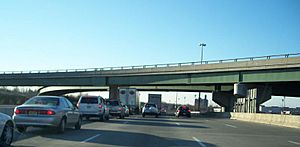
Despite the name, the Hudson-Bergen Light Rail does not yet run into Bergen County, although a northward extension from Hudson County to Englewood Hospital and Medical Center, known as the Northern Branch Corridor Project, has been advanced to the draft environmental impact statement stage by NJ Transit. The proposed Passaic-Bergen Rail Line, with two station stops in Hackensack, has not advanced since its 2008 announcement. The Access to the Region's Core rail tunnel project would have allowed many Bergen County railway commuters a one-seat ride into Manhattan but was canceled in October 2010.
Local and express bus service is available from NJ Transit and private companies such as Academy Bus Lines, Coach USA, DeCamp Bus Lines and Red and Tan Lines, offering transport within Bergen County, elsewhere in New Jersey, and to the Port Authority Bus Terminal and George Washington Bridge Bus Station in New York City. In studies conducted to determine the best possible routes for the Bergen BRT (bus rapid transit) system, it has been determined the many malls and other "activity generators" in the vicinity of the intersection of routes 4 and 17 would constitute the core of any system. While no funding has for construction of the project has been identified, a study begun in 2012 will define the optimal routes.
There is one airport in the county, Teterboro Airport in Teterboro, which is operated by the Port Authority of New York and New Jersey. The three busiest commercial airports in the New York City metropolitan area, namely JFK International Airport, Newark Liberty International Airport, and La Guardia Airport, are all located within 25 miles of Bergen County.
For the main surface-street routes through the county, see List of county routes in Bergen County, New Jersey.
Arts and culture
The Bergen Performing Arts Center (PAC) is based in Englewood, while numerous museums are located throughout the county. In September 2014, the Englewood-based Northern New Jersey Community Foundation announced an initiative known as ArtsBergen, a centralizing body with the goal of connecting artists and arts organizations with one another in Bergen County.
Municipalities

In the last decades of the 19th century, Bergen County, to a far greater extent than any other county in the state, began dividing its townships up into incorporated boroughs; this was chiefly due to the "boroughitis" phenomenon, triggered by a number of loopholes in state laws that allowed boroughs to levy lower taxes and send more members to the county's board of freeholders. There was a 10-year period in which many of Bergen County's townships disappeared into the patchwork of boroughs that exist today, before the state laws governing municipal incorporation were changed.
Municipalities in Bergen County (with 2010 Census data for population, housing units and area) are:
| Municipality (with map key) |
Municipal type |
Population | Housing Units |
Total Area |
Water Area |
Land Area |
Pop. Density |
Housing Density |
Communities |
|---|---|---|---|---|---|---|---|---|---|
| Allendale | borough | 6,505 | 2,388 | 3.12 | 0.02 | 3.10 | 2,100.7 | 771.2 | |
| Alpine | borough | 1,849 | 670 | 9.23 | 2.82 | 6.41 | 288.4 | 104.5 | |
| Bergenfield | borough | 26,764 | 9,200 | 2.89 | 0.01 | 2.88 | 9,306.5 | 3,199.1 | |
| Bogota | borough | 8,187 | 2,888 | 0.81 | 0.05 | 0.76 | 10,702.5 | 3,775.4 | |
| Carlstadt | borough | 6,127 | 2,495 | 4.24 | 0.24 | 4.00 | 1,532.1 | 623.9 | |
| Cliffside Park | borough | 23,594 | 10,665 | 0.96 | 0.00 | 0.96 | 24,508.7 | 11,078.5 | Grantwood (part) |
| Closter | borough | 8,373 | 2,860 | 3.30 | 0.13 | 3.16 | 2,646.0 | 903.8 | |
| Cresskill | borough | 8,573 | 3,114 | 2.07 | 0.01 | 2.06 | 4,154.5 | 1,509.0 | |
| Demarest | borough | 4,881 | 1,659 | 2.08 | 0.01 | 2.07 | 2,361.8 | 802.7 | |
| Dumont | borough | 17,479 | 6,542 | 1.99 | 0.00 | 1.98 | 8,814.7 | 3,299.2 | |
| East Rutherford | borough | 8,913 | 4,018 | 4.05 | 0.34 | 3.71 | 2,403.2 | 1,083.4 | |
| Edgewater | borough | 11,513 | 6,282 | 2.42 | 1.49 | 0.94 | 12,312.0 | 6,718.0 | |
| Elmwood Park | borough | 19,403 | 7,385 | 2.76 | 0.11 | 2.65 | 7,327.9 | 2,789.1 | |
| Emerson | borough | 7,401 | 2,552 | 2.40 | 0.20 | 2.20 | 3,358.9 | 1,158.2 | |
| Englewood | city | 27,147 | 10,695 | 4.94 | 0.02 | 4.91 | 5,524.6 | 2,176.5 | |
| Englewood Cliffs | borough | 5,281 | 1,924 | 3.33 | 1.24 | 2.09 | 2,528.1 | 921.0 | |
| Fair Lawn | borough | 32,457 | 12,266 | 5.20 | 0.06 | 5.14 | 6,315.4 | 2,386.7 | Radburn |
| Fairview | borough | 13,835 | 5,150 | 0.84 | 0.00 | 0.84 | 16,421.8 | 6,112.9 | |
| Fort Lee | borough | 35,345 | 17,818 | 2.89 | 0.35 | 2.54 | 13,910.9 | 7,012.7 | |
| Franklin Lakes | borough | 10,590 | 3,692 | 9.85 | 0.47 | 9.38 | 1,129.1 | 393.6 | |
| Garfield | city | 30,487 | 11,788 | 2.16 | 0.06 | 2.10 | 14,524.8 | 5,616.1 | |
| Glen Rock | borough | 11,601 | 4,016 | 2.74 | 0.02 | 2.71 | 4,275.2 | 1,480.0 | |
| Hackensack | city | 43,010 | 19,375 | 4.35 | 0.17 | 4.18 | 10,290.0 | 4,635.4 | |
| Harrington Park | borough | 4,664 | 1,624 | 2.06 | 0.23 | 1.83 | 2,545.9 | 886.5 | |
| Hasbrouck Heights | borough | 11,842 | 4,627 | 1.51 | 0.00 | 1.51 | 7,865.4 | 3,073.2 | |
| Haworth | borough | 3,382 | 1,136 | 2.36 | 0.41 | 1.94 | 1,739.2 | 584.2 | |
| Hillsdale | borough | 10,219 | 3,567 | 2.96 | 0.01 | 2.95 | 3,464.8 | 1,209.4 | |
| Ho-Ho-Kus | borough | 4,078 | 1,462 | 1.75 | 0.01 | 1.74 | 2,350.3 | 842.6 | |
| Leonia | borough | 8,937 | 3,428 | 1.63 | 0.10 | 1.54 | 5,819.5 | 2,232.2 | |
| Little Ferry | borough | 10,626 | 4,439 | 1.70 | 0.23 | 1.48 | 7,200.1 | 3,007.8 | |
| Lodi | borough | 24,136 | 10,127 | 2.29 | 0.02 | 2.26 | 10,657.6 | 4,471.7 | |
| Lyndhurst | township | 20,554 | 8,787 | 4.89 | 0.34 | 4.56 | 4,509.3 | 1,927.7 | Kingsland |
| Mahwah | township | 25,890 | 9,868 | 26.19 | 0.50 | 25.69 | 1,007.7 | 384.1 | Cragmere Park, Darlington, Fardale, Masonicus, Pulis Mills |
| Maywood | borough | 9,555 | 3,769 | 1.29 | 0.00 | 1.29 | 7,428.0 | 2,930.0 | |
| Midland Park | borough | 7,128 | 2,861 | 1.56 | 0.01 | 1.56 | 4,583.2 | 1,839.6 | Wortendyke |
| Montvale | borough | 7,844 | 2,872 | 4.01 | 0.01 | 4.00 | 1,961.2 | 718.1 | |
| Moonachie | borough | 2,708 | 1,053 | 1.68 | 0.01 | 1.66 | 1,626.5 | 632.5 | |
| New Milford | borough | 16,341 | 6,362 | 2.31 | 0.03 | 2.27 | 7,186.0 | 2,797.7 | |
| North Arlington | borough | 15,392 | 6,573 | 2.62 | 0.06 | 2.56 | 6,010.3 | 2,566.6 | |
| Northvale | borough | 4,640 | 1,635 | 1.30 | 0.00 | 1.30 | 3,582.3 | 1,262.3 | |
| Norwood | borough | 5,711 | 2,007 | 2.73 | 0.01 | 2.73 | 2,093.5 | 735.7 | |
| Oakland | borough | 12,754 | 4,470 | 8.73 | 0.27 | 8.45 | 1,508.6 | 528.7 | |
| Old Tappan | borough | 5,750 | 1,995 | 4.20 | 0.87 | 3.33 | 1,725.8 | 598.8 | |
| Oradell | borough | 7,978 | 2,831 | 2.58 | 0.15 | 2.42 | 3,291.5 | 1,168.0 | |
| Palisades Park | borough | 19,622 | 7,362 | 1.28 | 0.02 | 1.25 | 15,681.6 | 5,883.6 | |
| Paramus | borough | 26,342 | 8,915 | 10.52 | 0.05 | 10.47 | 2,516.0 | 851.5 | Arcola |
| Park Ridge | borough | 8,645 | 3,428 | 2.60 | 0.02 | 2.58 | 3,348.6 | 1,327.8 | |
| Ramsey | borough | 14,473 | 5,550 | 5.59 | 0.07 | 5.52 | 2,621.9 | 1,005.4 | |
| Ridgefield | borough | 11,032 | 4,145 | 2.85 | 0.30 | 2.55 | 4,323.7 | 1,624.5 | Grantwood (part) |
| Ridgefield Park | village | 12,729 | 5,164 | 1.92 | 0.20 | 1.72 | 7,385.6 | 2,996.2 | |
| Ridgewood | village | 24,958 | 8,743 | 5.82 | 0.07 | 5.75 | 4,339.0 | 1,520.0 | |
| River Edge | borough | 11,340 | 4,261 | 1.90 | 0.04 | 1.85 | 6,116.3 | 2,298.2 | |
| River Vale | township | 9,659 | 3,521 | 4.28 | 0.26 | 4.01 | 2,408.1 | 877.8 | |
| Rochelle Park | township | 5,530 | 2,170 | 1.06 | 0.02 | 1.04 | 5,313.8 | 2,085.2 | |
| Rockleigh | borough | 531 | 86 | 0.98 | 0.01 | 0.97 | 548.1 | 88.8 | |
| Rutherford | borough | 18,061 | 7,278 | 2.94 | 0.14 | 2.81 | 6,437.4 | 2,594.1 | |
| Saddle Brook | township | 13,659 | 5,485 | 2.72 | 0.03 | 2.69 | 5,080.2 | 2,040.0 | |
| Saddle River | borough | 3,152 | 1,341 | 4.98 | 0.06 | 4.92 | 640.2 | 272.4 | |
| South Hackensack | township | 2,378 | 879 | 0.74 | 0.02 | 0.72 | 3,311.7 | 1,224.1 | |
| Teaneck | township | 39,776 | 14,024 | 6.23 | 0.22 | 6.01 | 6,622.2 | 2,334.8 | |
| Tenafly | borough | 14,488 | 4,980 | 5.18 | 0.58 | 4.60 | 3,148.6 | 1,082.3 | |
| Teterboro | borough | 67 | 27 | 1.16 | 0.00 | 1.16 | 57.9 | 23.3 | |
| Upper Saddle River | borough | 8,208 | 2,776 | 5.28 | 0.02 | 5.26 | 1,560.0 | 527.6 | |
| Waldwick | borough | 9,625 | 3,537 | 2.09 | 0.02 | 2.07 | 4,656.8 | 1,711.3 | |
| Wallington | borough | 11,335 | 4,946 | 1.03 | 0.05 | 0.98 | 11,528.6 | 5,030.5 | |
| Washington Township | township | 9,102 | 3,341 | 2.96 | 0.05 | 2.91 | 3,128.8 | 1,148.5 | |
| Westwood | borough | 10,908 | 4,636 | 2.31 | 0.05 | 2.27 | 4,814.5 | 2,046.2 | |
| Woodcliff Lake | borough | 5,730 | 1,980 | 3.61 | 0.20 | 3.41 | 1,682.7 | 581.5 | |
| Wood-Ridge | borough | 7,626 | 3,051 | 1.10 | 0.00 | 1.10 | 6,951.6 | 2,781.2 | |
| Wyckoff | township | 16,696 | 5,827 | 6.61 | 0.06 | 6.55 | 2,550.1 | 890.0 | |
| Bergen County | county | 905,116 | 352,388 | 246.67 | 13.66 | 233.01 | 3,884.5 | 1,512.3 |
Historical municipalities
Over the history of the county, there have been various municipality secessions, annexations and renamings. The following is a partial list of former municipalities, ordered by year of incorporation.
|
|
Points of interest
Educational and cultural
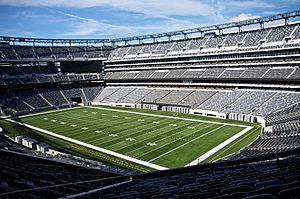

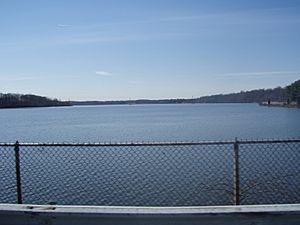
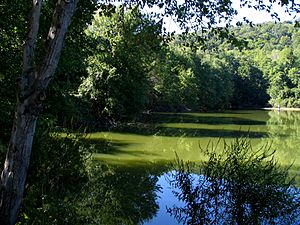
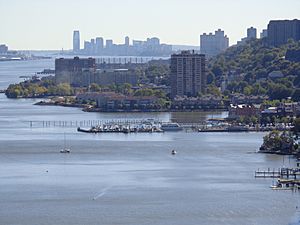
- New Jersey Naval Museum, Hackensack. At the museum, the USS Ling is moored in the Hackensack River and is available for tours as a museum ship.
- Aviation Hall of Fame and Museum of New Jersey, located at Teterboro Airport in Teterboro.
- Bergen Museum of Art & Science, Hackensack.
- Buehler Challenger & Science Center, Paramus — Located on the campus of Bergen Community College.
- Meadowlands Environment Center, Lyndhurst.
- Tenafly Nature Center, Tenafly
- Puffin Foundation, Teaneck
- Maywood Station Museum, Maywood
- Bergen Performing Arts Center, Englewood
Commercial and entertainment
- MetLife Stadium, which replaced Giants Stadium, in East Rutherford, is the home of the New York Giants and the New York Jets of the National Football League. At a construction cost of approximately $1.6 billion, it is the most expensive stadium ever built.
- Izod Center, East Rutherford (formerly known as the Continental Airlines Arena and the Brendan Byrne Arena). Opened in 1981, it was formerly home to the New Jersey Devils of the National Hockey League, the New Jersey Nets of the National Basketball Association, and the Seton Hall University Pirates men's basketball team. Izod Center closed on April 3, 2015.
- Meadowlands Racetrack, East Rutherford
- Westfield Garden State Plaza, Paramus, is one of the largest and highest revenue producing shopping malls in the United States.
- The Shops at Riverside, shopping mall, Hackensack (formerly known as Riverside Square Mall)
- Paramus Park, shopping mall, Paramus
- The Outlets at Bergen Town Center, shopping mall, Paramus (formerly known as the Bergen Mall)
- Fashion Center, shopping mall, Paramus
- H Mart, Korean shopping plaza and supermarket, Ridgefield
- Mitsuwa Marketplace, Japanese shopping plaza and supermarket, Edgewater
- American Dream Meadowlands, retail and entertainment complex under construction. The expected opening date will be summer of 2017.
State parks
- Ramapo Mountain State Forest, Mahwah
- Palisades Interstate Park, Fort Lee, Englewood Cliffs, Tenafly, Alpine
State-owned historical sites
- New Bridge Landing, River Edge, Teaneck and New Milford
- The Hermitage, Ho-Ho-Kus
- Steuben House, River Edge (at New Bridge Landing)
County parks
- Belmont Hill County Park, Garfield
- Campgaw Mountain Reservation, Mahwah
- Dahnert's Lake County Park, Garfield
- Darlington County Park, Mahwah
- McFaul Environmental Center, Wyckoff
- Ramapo Valley County Reservation, Mahwah
- Overpeck County Park, Leonia, Palisades Park, Ridgefield Park
- Riverside County Park, Lyndhurst, North Arlington
- Pascack Brook County Park, Westwood
- Saddle Ridge Riding Area, Franklin Lakes
- Saddle River County Park, Paramus, Glen Rock, Rochelle Park, Saddle Brook, Ridgewood
- Samuel Nelkin County Park, Wallington
- Van Saun County Park, Paramus, including the Bergen County Zoological Park, the county's only zoo. The zoo was slated for an expansion as of 2016 which would nearly double its size from 12 to 23 acres and significantly diversify its population of animal species.
- Wood Dale County Park, Woodcliff Lake
County-owned historical sites
- Baylor Massacre site, River Vale - location of a surprise attack on September 27, 1778, against the 3rd Regiment of Continental Light Dragoons under the command of Colonel George Baylor during the American Revolutionary War.
- Camp Merritt, Cresskill
- Campbell-Christie House, River Edge - a historic Dutch sandstone home, it was moved from New Milford to preserve the home from destruction.
- Easton Tower, Paramus
- Garretson Farm, Fair Lawn - a stone home dating to the 1720s that is one of the county's oldest surviving structures.
- Gethsemane Cemetery, Little Ferry
- Washington Spring Garden, located in Van Saun Park, Paramus
- Wortendyke Barn, Park Ridge
Economy
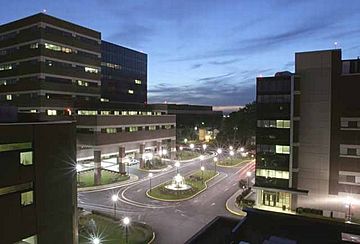
Based on data from the Bureau of Economic Analysis, Bergen County had a gross domestic product (GDP) of $66.1 billion in 2018, which was ranked 1st in the state and represented an increase of 2.6% from the previous year.
Largest employers
According to the Bergen County Economic Development Corporation, the largest employers in Bergen County as of November 2012, as ranked with at least 1,000 employees in the county, were as follows:
- Hackensack University Medical Center, Hackensack, 8,000
- Valley Health System, Ridgewood, 4,660
- Bio-Reference Laboratories, Inc., Elmwood Park, 2,900
- Medco Health Solutions, Franklin Lakes, 2,800 (no longer an independent company)
- County of Bergen, Hackensack, 2,390
- Quest Diagnostics, Teterboro / Lyndhurst, 2,200
- KPMG, Montvale, 2,100
- Englewood Hospital and Medical Center, Englewood, 2,002
- Englewood Hospital Home Health Care Services, Englewood, 1,985
- Unilever Bestfoods, Englewood Cliffs, 1,900
- Stryker Corporation, Allendale / Mahwah, 1,812
- Bergen Regional Medical Center, Paramus, 1,746
- Holy Name Medical Center, Teaneck, 1,695
- Becton Dickinson, Franklin Lakes, 1,500
- Crestron Electronics, Rockleigh / Cresskill, 1,500
- BMW of North America, Woodcliff Lake, 1,000
In January 2015, Mercedes-Benz USA announced that it would be moving its headquarters from the borough of Montvale in Bergen County to the Atlanta, Georgia area as of July. The company had been based in northern New Jersey since 1972 and has had 1,000 employees on a 37-acre (15 ha) campus in Montvale. Despite incentive offers from the State of New Jersey to remain in Bergen County, Mercedes-Benz cited proximity to its Alabama manufacturing facility and a growing customer base in the southeastern United States, in addition to as much as $50 million in tax incentives from Georgia governmental agencies, in explaining its decision to move. However, Mercedes-Benz USA also stated its intent to maintain its Northeast regional headquarters in Montvale and to build a "state-of-the-art" assemblage training center in the borough as well.
Building permits
In 2011, Bergen County issued 1,903 new building permits for residential construction, the largest number in New Jersey.
Retail
The retail industry, anchored in Paramus, is a mainstay of the Bergen County economy, with a combined payroll of $1.7 billion as of 2012.
Blue laws
Bergen County enforces one of the last remaining blue laws in the United States that covers most retail sales, other than food and gasoline (among other limited items). The law enforced in the county is actually a state law that each county could reject by voter referendum, with 20 of the state's 21 counties having voted to reject the legal option to enforce the law. Thus one of the largest and most popular commercial shopping cores of the New York metropolitan area is almost completely closed on Sunday. Grocery stores, convenience stores, gas stations, hotels, restaurants, pharmacies, entertainment venues, and any other exempted establishments that do not sell clothing, shoes, furniture, electronics, hardware, and home appliances are among the businesses allowed to operate. Furthermore, Bergen County has significant populations of Jewish (2000 estimate of 83,700) and Muslim (2000 estimate of 6,473) residents whose observant members would not be celebrating the Sunday Sabbath with most of their Christian neighbors. The substantial Orthodox Jewish minority is placed in the position of being unable to shop either on Sunday (due to the blue laws) or on Saturday (due to religious observance).
However, repeated attempts by voters to reject the law have failed. A large part of the reason for maintaining the laws has been a desire by many Bergen County residents for relative peace and quiet, with less traffic, on one day of the week. This desire for relative peace is most apparent in Paramus, where most of the county's largest shopping malls are located, along the intersecting highways of Route 4 and Route 17, which are jam-packed on many Saturdays. Paramus has enacted blue laws of its own that are even more restrictive than those enforced by Bergen County, banning all forms of "worldly employment" on Sundays, including white collar workers in office buildings. Despite these strict blue laws, Paramus (07652) has become the top retail ZIP Code in the United States, with the municipality generating over US$6 billion in annual retail sales. Local blue laws in Paramus were first proposed in 1957, while the Bergen Mall (since renamed as The Outlets at Bergen Town Center) and Garden State Plaza were under construction. The legislation was motivated by fears that the two new malls would aggravate the already severe highway congestion caused by local retail businesses along the borough's highways seven days a week and to preserve one day on which the roads were less congested. In November 2012, Governor Chris Christie issued an executive order to temporarily suspend the blue law due to the effects of Hurricane Sandy. The blue law was suspended on November 11 but was back in effect one week later.
Minimum wage
In November 2017, County Executive James Tedesco raised the minimum wage for full-time Bergen County workers to $15 per hour gradually increasing over a 6-year period, an increase from the prevailing state minimum wage at the time of $8.44 hourly. The raise constituted the first such hike in the minimum wage paid to employees of any New Jersey county.
Education
Bergen County is home to several colleges and universities:
- Bergen Community College – Paramus, with other centers in Hackensack and Lyndhurst
- Fairleigh Dickinson University – Teaneck and Hackensack
- Felician University – Lodi and Rutherford
- Ramapo College – Mahwah
Bergen has some 45 public high schools and at least 23 private high schools. Three of the top ten municipal high schools out of 339 schools in New Jersey were located in Bergen County, according to a 2014 ranking by New Jersey Monthly magazine, including Northern Highlands Regional High School in Allendale (#3), Pascack Hills High School in Montvale (#7), and Glen Rock High School in Glen Rock (#8). The magazine's list did not include the Bergen County Academies (BCA), which as the county's public magnet high school in Hackensack has continued to be recognized by various rankings as one of the best high schools in the United States. In 2014, BCA had an average HSPA score of 294 out of 300 and an average SAT score of 2103 out of 2400.
In 1987 there were five juku (Japanese-style cram schools) in the county, with two of them in Fort Lee.
Images for kids
-
View north along the Shore Trail near the Forest View Trail in Palisades Interstate Park
See also
 In Spanish: Condado de Bergen para niños
In Spanish: Condado de Bergen para niños







